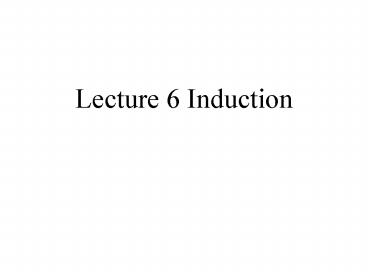Lecture 6 Induction - PowerPoint PPT Presentation
1 / 16
Title:
Lecture 6 Induction
Description:
It is actually a deductive technique, not a method of inductive. ... an arbitrary positive integer k in order to prove that P(k 1) is true. ... – PowerPoint PPT presentation
Number of Views:32
Avg rating:3.0/5.0
Title: Lecture 6 Induction
1
- Lecture 6 Induction
2
Induction
- Given that you are climbing an infinitely high
ladder. - Question How to you know whether you will be
able to reach an arbitrarily high rung?
3
Two assertions
- You can reach the first rung.
- Once you get to a rung, you can always climb to
the next one up. - Assertion 1 sets the starting point.
- Assertion2 guarantees that you can go beyond the
first rung . - This technique can be used to prove properties
for all positive integers.
4
- Two assertions to prove?
1 has property P
- P(1)
- For any positive integer k, P(k)?P(k1)
if we can prove this, P(n) holds for any positive
integer n
If any number has property p, so does the next
number.
5
First Principle of Mathematical Induction
Inductive assumption or inductive hypothesis
Basis step
- P(1) is true
- (?k)P(k) true ? P(k1) true
P(n) true for all positive integers n.
to show that this is true
Inductive step
We show that 1 2 are true
6
How do we prove 1 2?
- Prove 1
- We need only show that property P holds for the
- number 1.
- Prove 2 (Implication that must hold for all k)
- We need to assume that P(k) is true for an
- arbitrary integer k.
- Show that P(k1) is true based on the previous
- assumption.
7
Mathematical induction
- Some issues to be cleared
- It is not an exploratory proof technique, it can
only confirm a correct conjecture. - It is actually a deductive technique, not a
method of inductive. - Even the conjecture is slightly incorrect, you
might see the correct conclusion during the proof.
8
Mathematical induction (cont.)
- Example Prove that the equation 135.(2n-1)
n2 - Base Step
- P(1) 1 12
- Inductive hypothesis (Assumption).
- P(k) 135(2k-1) k2
- Prove the next one up.
- P(k1) 135(2(k1)-1) ? (k1)2
9
Three steps for First Principle of induction
- Step 1---Prove the base case
- Step 2 Assume P(k)
- Step 3 Prove P(k1)
10
Mathematical induction (cont.)
- Example Prove that the equation P(n)
135.(2n-1) n2 - Base Step
- P(1) 1 12
- Inductive hypothesis (Assumption).
- P(k) 135(2k-1) k2
- Prove the next one up.
- P(k1) 135(2(k1)-1) ? (k1)2
11
Details on our example
- In short, P(k1) has ONE MORE TERM on its LEFT
SIDE than P(k) AND this term builds on P(k)
. - So, from P(n) 135.(2n-1) n2 with
nk1 - P(k1) P(k) (2(k1)-1)
- k2 2k21 subst fo
P(k) expand on rt - k2 2k 1
aft some arith. - (k 1) 2
QED
12
One more Example
- 123n n(n1)/2.
- Base Step
- P(1) 1 12/2
- Inductive hypothesis (Assumption).
- P(k) 123kk(k1)/2
- Prove the next one up.
- P(k1) 123(k1) ? (k1)((k1)1)/2
13
One more Example
- Inductive hypothesis (Assumption).
- P(k1) P(k) (k1)
- SHORT WAY add LAST
TERM - from P(k1)s LT
side expansion to P(k)
- (k(k1))/2 (k1)
aft subst for P(k) - (k1)k/2 (k1) aft
switchg 1st term order - (k1) (k/2 1) aft
factorg out (k1) - (k1) (k2)/2
aft simple arith - Youre done IF you recognize the RIGHT SIDE here!
14
Second Principle of Induction
- P(1) is true
- (?k) P(r) true for all r,
- 1 ? r ? k ?P(k1) true
P(n) true for all positive integers n
In statement 2 we can assume that P(r) is true
for all integers r between 1 and an arbitrary
positive integer k in order to prove that P(k1)
is true. Both principles of induction are
equivalent.
15
Second Principle BigTime Exs
- Bk ex 21 --- Fence problem
- Postage Stamp problems
- 1. Youre lookg at postage more than 8 cents
(Why not 80 cents? --- Joke, - daughter!) Show 5 and 8 cent stamps
do all possible cases! - Just prove it simple-mindedly for 8, 9,
10 cents and then you can add 3 - cents to 8 to get 11, to 9 to get 12
Obvious? - 2. Prob 66 (the bk gives the answer) and 67
4 and 5 cent stamps starting - at 12 cents LIKE, demo 12, 13, 14, 15
and play 4 games - Others We tend to ignore TIME PRESSURE!
Maybe too swift ? - 1. Parens in programming lang p 103, Ex 22
- 2. For all n GE 2, n is either prime or
product of primes
16
Exercises 2.2 Prob 4, 13
- 4. Prove (simple inductn) 1 3 6
(n(n1))/2 (n(n1)(n2))/6 - 1. Base case n1 1 (1 (11) (12))/6
--- A-OK! (Dont think - of n 0 aint THERE on the LEFT!)
- 2. Riot down DIRECTLY BELOW the problem
statement with - nk the case where nk1
- KEY POINT find the nk case embedded
in the k1 case and - do some arith (sometimes fancy
footwork!!) - Awesome thing to look at you have the answer in
your book! - 1. Again, the base case is n1 and is
easy - 2. You gotta solve k/(k1) 1/(k1)(k2)
? (k1)/(k2) via - one of those common denominator
thing (mult by (k2) on the first - term on the left































